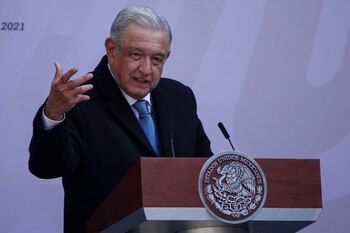
Since the beginning of President López Obrador's government, there was talk of a Mandate Revocation, yesterday, April 10, it became a reality. This means that, through the vote, citizens were asked if they agree that their mandate be revoked due to loss of confidence or remain in the Presidency of the Republic until the end of their term. Like every electoral exercise in the country, it was planned and organized by the National Electoral Institute (INE).
But what does the Act tell us about participation in exercise? According to the Federal Law on the Revocation of Mandate, article 7 provides that at least 3% of persons registered on the nominal voter list shall be required and provided that it is supported by the request of 17 states and supported by 3% of those registered on the nominal list of voters of the states.
If the Mandate Revocation is only done, if citizenship requires it, why don't we see them leading this exercise? Throughout the period, it was headed by the federal government; while citizens divided their opinions, some if they agree to participate and others point out that it is only a pantomime and unnecessary expense of the treasury.
An example of this is the constant support of governors related to the fourth transformation, who point out that attempts to postpone the revocation are merely censorship and blocking the INE against popular participation. Although the INE requested to withdraw each of the communiqués in favor, the governors constantly reiterated their support for the president and his office.

The conflict arose because, according to the INE, it organized the revocation with the minimum necessary. According to INE communiqué 047, 3,830 million pesos were requested; however, the Ministry of Finance and Public Credit (SHCP) granted 1,567.4 million pesos. This led to the INE wanting to postpone the exercise; however, the Supreme Court of Justice of the Nation (SCJN) ordered that the activities be continued.
What are the implications of this exercise? To begin to answer this, it is necessary to analyze the participation that was in the election. According to article 58 of the Act, revocation only proceeds if at least 40 per cent of the persons registered on the nominal voter list had been registered. Otherwise 1. Vote less than 40% of the electoral pattern or 2. The option of removing the president did not reach an absolute majority, he would end his term in 2024.
The scenario before voting by revocation of mandate, positioned the president as the winner of the citizen trust. According to the survey conducted by El Financiero, during the follow-up on the revocation of the mandate, the survey revealed that 52% prefer that he remain in office and 42% prefer that he not continue. This result is not surprising, since this same poll indicates that in February the President had an approval of 54% and a disapproval of 43%.
On April 10, hundreds of Mexicans went out to exercise our right to vote. According to the Preliminary Results of Infobae, at 21:00 hours the INE reported on its rapid count, preliminarily citizen participation ranged between 17 and 18.2%. Of this, the answers voted on were distributed as follows: 1. that his mandate be revoked due to loss of confidence: between 6.4 and 7.8%; 2. to remain in the Presidency of the Republic: between 90.3 and 91.9% and, 3. invalid votes: between 1.6 and 2.1%.

In addition, information was also provided on electronic voting. Which had 46.53% participation. On this, 1,6324 voters decided that the president would continue to lead the presidency of Mexico; 1915 voters decided that the Mandate Revocation should be given and, 48 were null and void. In both types of voting, the vote favors President Andrés Manuel. However, the results show that this democratic exercise will not be binding.
What is coming to us after April 10? President Andrés Manuel has stated that he will carry out an electoral reform that generally aims to:
1. eliminate multimember deputies and senators; 2. reduce costs in elections and, 3. that a single agency organize federal and local elections by disappearing Local Public Electoral Agencies (OPLES). This would represent a setback, since it would centralize the federal elections, as we have seen in the decisions of the current government.
Definitely, the creation of the Mandate Revocation figure favors our democracy, where the government takes accountability, transparency and citizen participation seriously so that we can inform and question them on the basis of results whether they are satisfied with the current government or not.

However, care must be taken in who promotes it and the reasons why it is being done. That is why criticism focused on noting that the president is seeking to ratify the legitimacy of his government, based on the polls and the participation he received.
The problem with the Revocation of Mandate being led by who promotes it is that it is only carried out with political overtones and in a way that suits them and not, like what it is designed to be: a democratic exercise to ask citizens whether or not they agree with its management. Therefore, whether or not this exercise is a simulation of the federal government, citizens must appropriate these exercises to demonstrate our disagreement.
*Amparo Hinterholzer holds a degree in politics and social management, UAM Xochimilco @AmpHinterholzer
KEEP READING:
Últimas Noticias
Debanhi Escobar: they secured the motel where she was found lifeless in a cistern

The oldest person in the world died at the age of 119

Macabre find in CDMX: they left a body bagged and tied in a taxi
The eagles of America will face Manchester City in a duel of legends. Here are the details

Why is it good to bring dogs out to know the world when they are puppies




